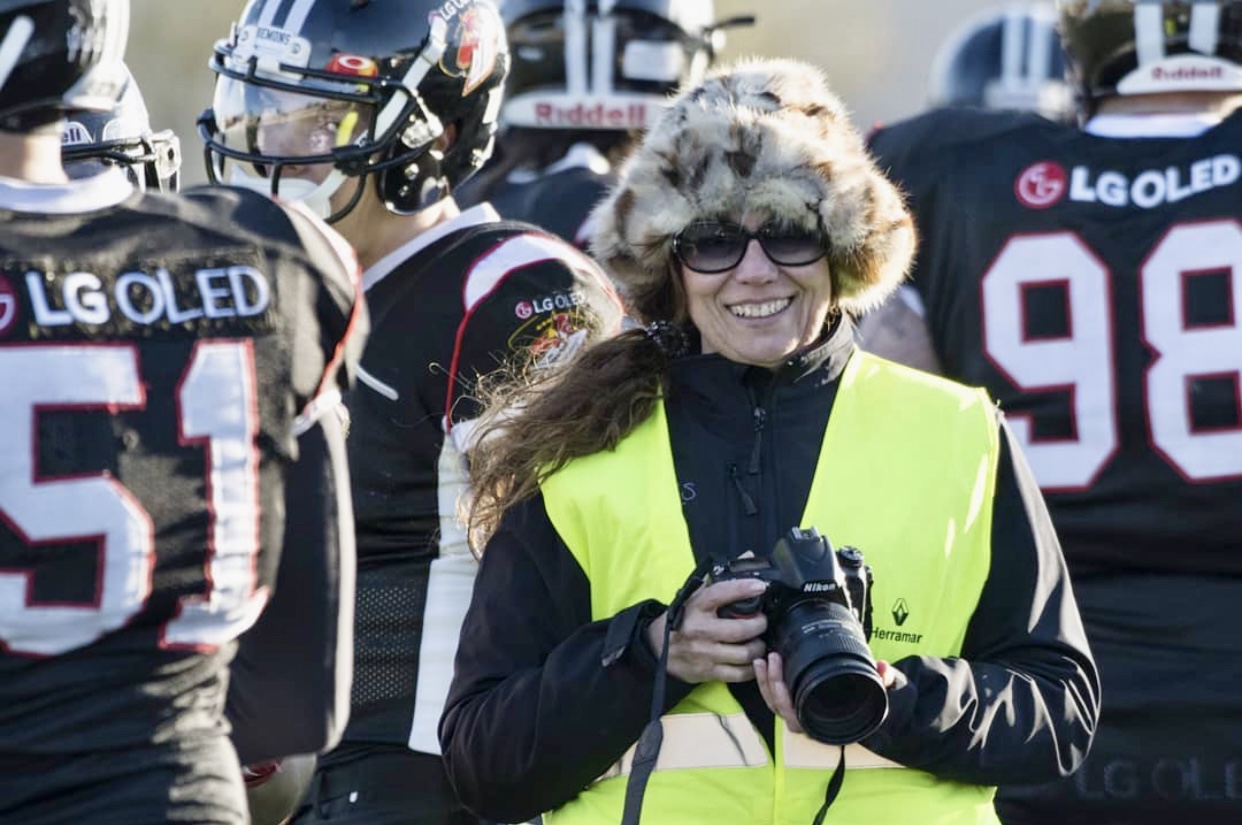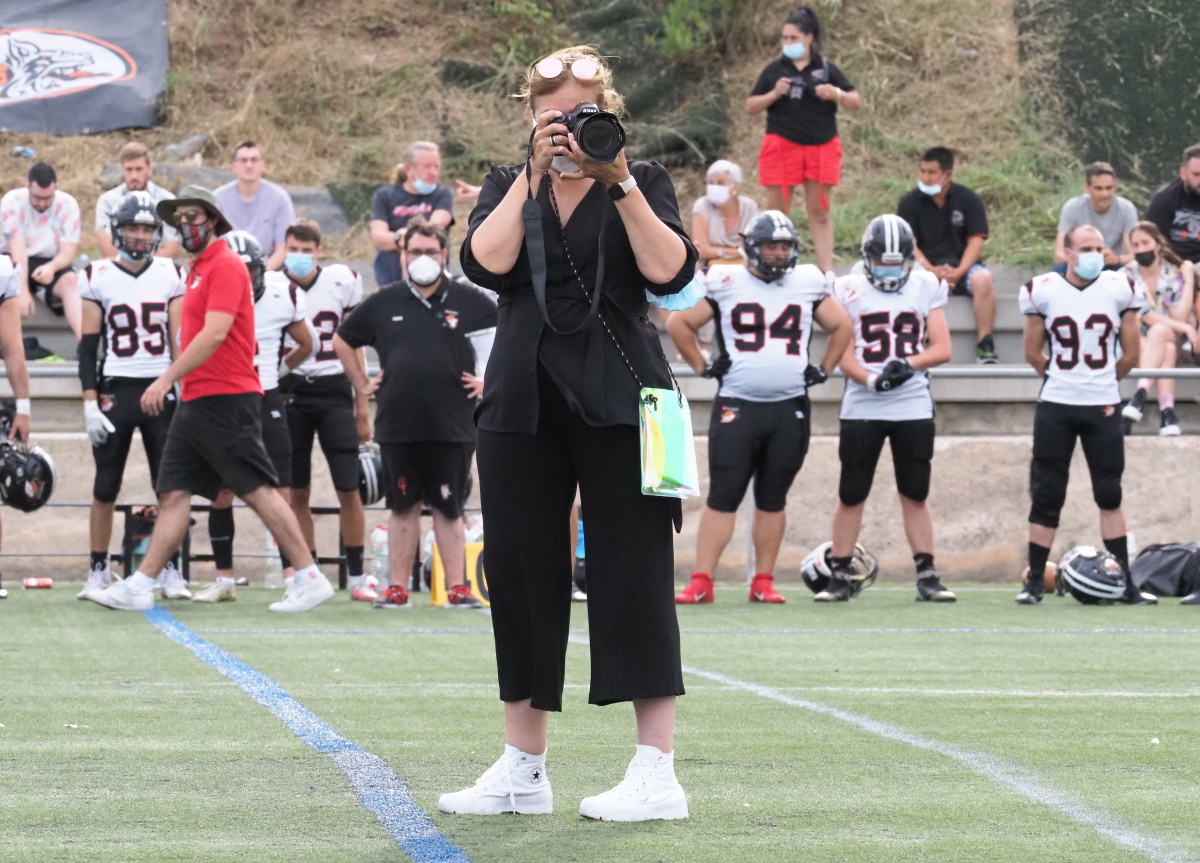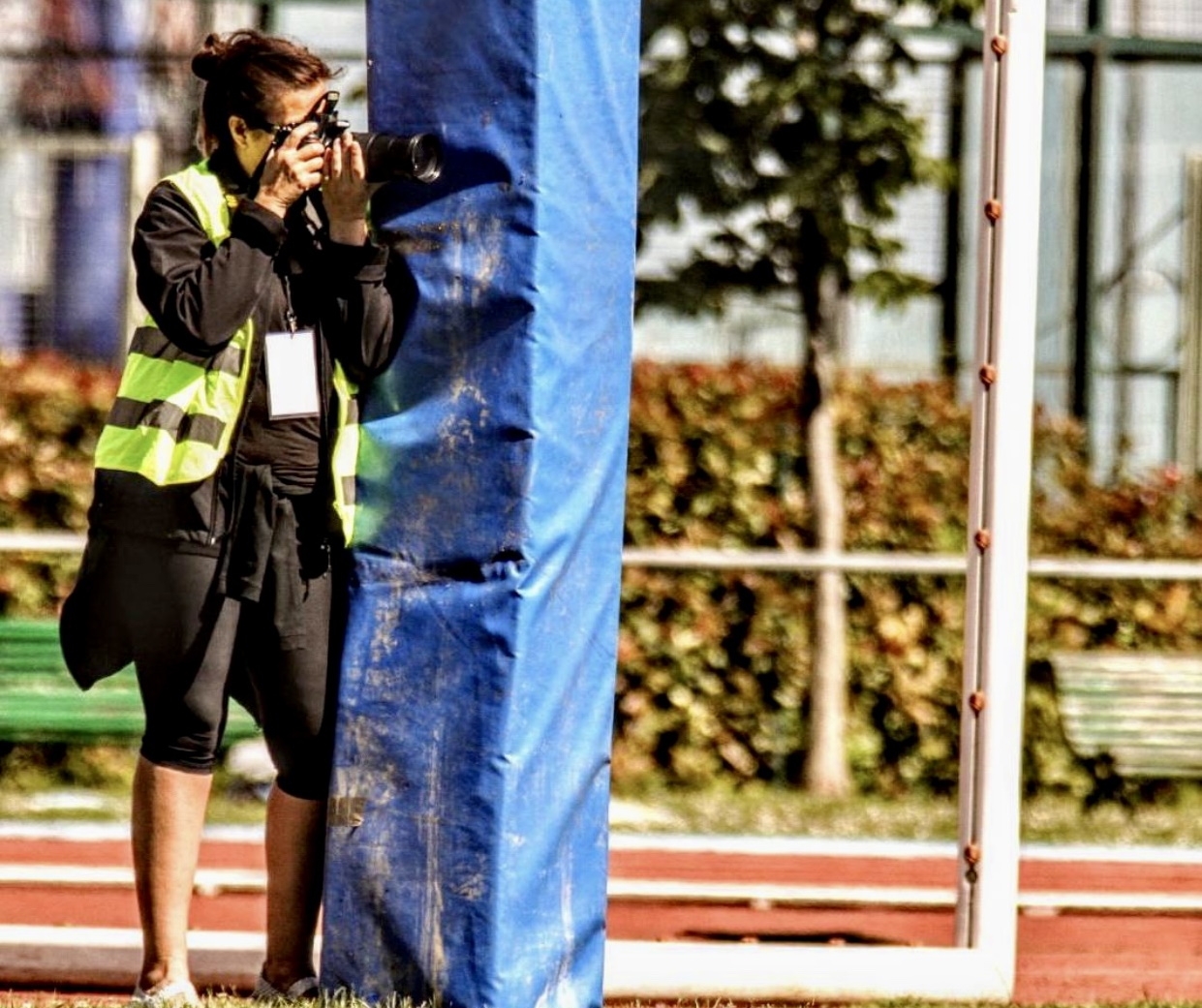Lola Morales, Spain’s thoughtful football photographer: “I try to reflect the emotional part of the players”

By Roberto Arturo
Any fan who has the opportunity to watch a Las Rozas Black Demons game in Spain’s National League of American Football will probably notice a female photographer moving from one side of the field to the other, in her quest to get the best image of the players.
Her name is Lola Morales.
Lola has been photographing the game for eight years, collaborating with both the Black Demons and the Spanish American Football Federation, covering both tackle and flag football. She is adamant about taking the players into consideration when taking their pictures.
“I try to reflect the emotional part of the players”
AFI took the time to ask Morales about her introduction to the game, her thoughts about its growth and development and how she photographs games.
AFI: Could you tell us how you got into American Football?
Morales: Well, I am the mother of two football players. I really like taking photos of all kinds, this has always been my hobby. I am not a professional photographer. It has been a great challenge and it continues to be a great challenge because I always want to keep learning.
It all started when my children joined Black Demons, here in Las Rozas in Madrid. When they started playing, one was 23 years old and the other 16. They played for seven years, but this year none of them are playing for work reasons. We once went with friends to see a game in Italy for the Junior and Women’s teams and when I got there, since I had my camera with me, the sports director’s wife encouraged me to cover the game.
“Once you are on the edge of the field taking photos you do not have a child, you have 45 children.”
I kept taking pictures of American football because my youngest son, despite being very big at the time, with his height of over 1.80 meters and 128 kg while playing center, scared me a lot in the plays. However, if I looked at the action of the play through my camera, my stomach felt better. On the contrary, my eldest son tells me that I never worry about him, but it is not true. What happens is that he ran a lot, he was a very fast wide receiver, so he hardly got hit.
I am quite empathetic with all the players because once you are on the edge of the field taking photos you do not have a child, you have 45 children.
AFI: How difficult is your job? How many photos do you usually take in a game?
Morales: It all depends on the game; I don’t have continuous shooting because it would lose a lot of quality. So, I have to take the photographs at the exact best moments, or I lose them. What happens is that I have a very special feeling with my camera and the truth is that it gives me a lot of satisfaction
When the game is very complicated, I can take about 1,500 photos. I have been learning throughout the process and I am still learning. For example, I don’t know how to Photoshop like some of my peers, however, I edit my photos by marking and lighting them, which is something I can do without wasting too much time.
I’m restless during the game and I can’t stop moving all over the stadium and I always try to get the best perspective that offers more movement.
The truth is that I’m restless during the game and I can’t stop moving all over the stadium and I always try to get the best perspective that offers more movement. There are some shots that are much easier, like shooting the quarterback because he gives you more options, but I also love the lines, both defensive and offensive.
In the end, I try to get everyone out because I think that to help the Spanish federation to promote Spanish football you have to show that everyone on a team is important. Not only the quarterback is important, but also the line, everyone on defense, etc.
AFI: So you always try to photograph everyone, right?
The fact is that I like to keep track of who is on the playing field, so that everybody has a photograph. It is uncommon for a kid who has played to not have a photo. I do all this for free, so since I don’t make a living from it, what I try is to satisfy the emotional part of the players. Thus, I am the best paid in the world because hugs are from the heart.
Surely it has already happened in all houses that, when the players come home with bruises, when they arrive frustrated or, on the contrary, very happy, at least they have a photograph to keep a memory of the moment.
AFI: So your work gives you a lot of satisfaction. Have you traveled to many places?
Definitely. They don’t pay me directly, but football has given me the opportunity to travel to many places, most of the time, accompanying my children, and the other 45 “children” I have on the team. The Spanish federation has subsidized me a few times, although most of the time I finance it myself.
I have been very lucky that my children have not been bad athletes, and, thanks to this, we have had the opportunity to travel together. The eldest has been in the selection of both tackle and flag of the Spanish team.
Football has given me the opportunity to travel to many places, most of the time, accompanying my children, and the other 45 ‘children’ I have on the team.
We have been able to travel to Jerusalem in Israel with the Spanish flag team and then I have been to Belgium and Hungary with the tackle team. With the Junior category, Holland and last year we were in Bologna in Italy.
In the end, at home we like to travel a lot, so we have an extra motivation to do it: sometimes to accompany the boys, and other times to help because we try to do it as we can.

Photo: Joan Sancho
AFI: How do you see the growth of American football in Spain in the coming years?
The Spanish product is very good. The handicap we have is the lack of sponsorships.
Spanish Football has a great future, and I can see it with the Barcelona Dragons. There are many Spanish players that I have seen and I see them grow from their Junior categories because they have played with or against my children.
The budgets of the Spanish teams are usually low and that is the handicap. As soon as we have to travel within Spain we run out of money because the budgets are mostly made up of player fees plus some small help from the community or the town where you train and play. So if we had a little more money you could invest in allowing yourself the luxury of going out of Spain like we did with Demons last year when we went to France. Honestly it may get really expensive.
We have players of the stature of Alejandro Fernández, who, from my camera, I have seen grow since he was 15 years old and he is beastly. Lucas Masero is another great player among many others,
There are many guys who have the potential to be better and make it to the (ELF Barcelona) Dragons, but they can’t afford to drop out and go to Barcelona to play American football. The same thing happens with the women’s teams: Olga Sotillo, Cristina Pérez, Elvira Núñez, Mónica Rafecas, Carla Blanca or Leyre Ferrón are some of the dozens of women who have played or could play in any team in Europe. Well, and I don’t want to stop mentioning Allison Rodríguez, who is playing in Mexico.
In Spain, there are only a few players who can make a living from American football, so most of them do it as a hobby.
It’s a continuous learning job for me, but I love what I do and the smiles on the faces of the players are a great satisfaction for me.
AFI: Would you like to add something?
I feel very grateful to be able to help football grow in what is in my hands. It’s a continuous learning job for me, but I love what I do and the smiles on the faces of the players are a great satisfaction for me. I don’t want to end this interview without mentioning www.madriddiario.com, which offered me the opportunity to publish photos of the matches in order to promote knowledge of this sport. And to AFI, who wanted to have photos of me to illustrate some of their articles.
